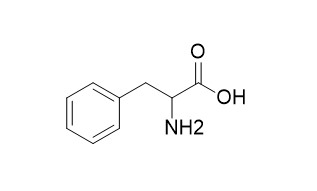DL-Phenylalanine
DL-phenylalanine,is known as an essential amino acid, it often appears to potentiate pain relief and also ease depression in patients receiving opiates for chronic non-malignant pain.
Inquire / Order:
manager@chemfaces.com
Technical Inquiries:
service@chemfaces.com
Tel:
+86-27-84237783
Fax:
+86-27-84254680
Address:
1 Building, No. 83, CheCheng Rd., Wuhan Economic and Technological Development Zone, Wuhan, Hubei 430056, PRC
Providing storage is as stated on the product vial and the vial is kept tightly sealed, the product can be stored for up to
24 months(2-8C).
Wherever possible, you should prepare and use solutions on the same day. However, if you need to make up stock solutions in advance, we recommend that you store the solution as aliquots in tightly sealed vials at -20C. Generally, these will be useable for up to two weeks. Before use, and prior to opening the vial we recommend that you allow your product to equilibrate to room temperature for at least 1 hour.
Need more advice on solubility, usage and handling? Please email to: service@chemfaces.com
The packaging of the product may have turned upside down during transportation, resulting in the natural compounds adhering to the neck or cap of the vial. take the vial out of its packaging and gently shake to let the compounds fall to the bottom of the vial. for liquid products, centrifuge at 200-500 RPM to gather the liquid at the bottom of the vial. try to avoid loss or contamination during handling.
Evid Based Complement Alternat Med.2020, 2020:2584783.
Biol Pharm Bull.2018, 41(11):1685-1693
Int J Mol Sci.2022, 23(5):2796.
PLoS One.2018, 13(11):e0208055
Evid Based Complement Alternat Med.2018, 2018:1073509
Int J Med Sci.2024, 21(15):2883-2896
Biotechnol Bioeng.2020, 117(7):2198-2208.
bioRxiv - Molecular Biology2023, 535548.
Sustainable Chemistry & Pharmacy2022, 30:100883.
Foods.2022, 12(1):136.
Related and Featured Products
Medical Hypotheses, 2000, 55(4):283-288.
DL-phenylalanine markedly potentiates opiate analgesia – an example of nutrient/pharmaceutical up-regulation of the endogenous analgesia system.[Reference:
WebLink]
METHODS AND RESULTS:
In the author’s clinical experience, concurrent treatment with
DL-Phenylalanine (DLPA) often appears to potentiate pain relief and also ease depression in patients receiving opiates for chronic non-malignant pain. An analysis of this phenomenon suggests that it may be mediated, at least in part, by up-regulation of the ‘endogenous analgesia system’ (EAS), a neural pathway that projects caudally from medullary nuclei to the dorsal horn of the spinal column; when stimulated by chronic pain or therapeutic measures such as opiates or acupuncture, the EAS suppresses activation of second-order pain-receptive neurons in the dorsal horn, and thereby alleviates pain. Since serotonin and enkephalins are key neurotransmitters in the EAS, it is reasonable to predict that measures which promote serotonin activity (such as 5-hydroxytryptophan and serotonin-reuptake inhibitors) as well as enkephalin activity (such as D-phenylalanine, an enkephalinase inhibitor) should potentiate EAS-mediated analgesia – a view consistent with much previous medical research.
CONCLUSIONS:
Comprehensive support of the EAS with well-tolerated nutrients and pharmaceuticals may amplify the analgesic efficacy of chronic opiate therapy, while enabling dosage reductions that minimize opiate side-effects. Analogously, this approach may complement the efficacy of acupuncture and other analgesic measures that activate the EAS.
Journal of the Korean Society of Food ence & Nutrition, 2007, 55(2):11-27.
Processing Properties of DL-Phenylalanine in Aqueous Solution.[Reference:
WebLink]
DL-Phenylalanine (DLPA) is known as an essential amino acid exhibiting opiate capacities by inhibiting the degradation of enkephalins. From the viewpoint of developing a drink containing DLPA, its solubility and stability in aqueous solutions were investigated at some processing conditions such as temperature and pH.
METHODS AND RESULTS:
When the solubility was analyzed by transmittance at 600 nm, the solutions containing DLPA of 0.1% to 2% showed transmittance over 98% above and over 99% at wide range of pH (3.0, 7.0, and 10.0). The valuable stability was also recognized through HPLC analysis for DLPA content, that is, 61-71% DLPA was still remained even after processing at high temperature and wide pH range, indicating the possibility of de-velopment of drink containing DLPA.
CONCLUSIONS:
Among flavors considered for the improvement of consumers` acceptability on drink, orange and amino acid flavors were superior to others. Microbial growth was not detected during 6-week storage after drink preparation.



